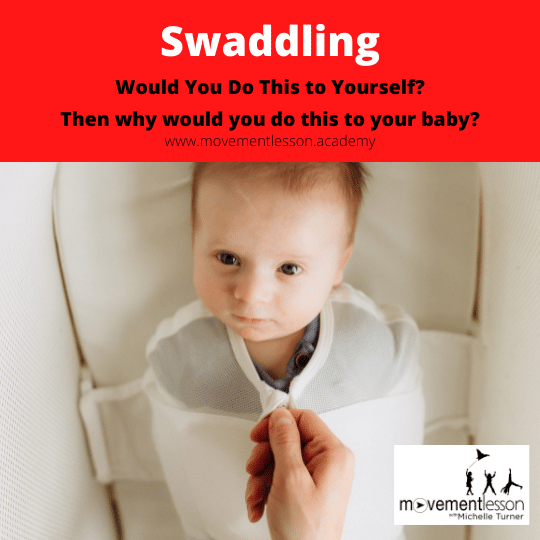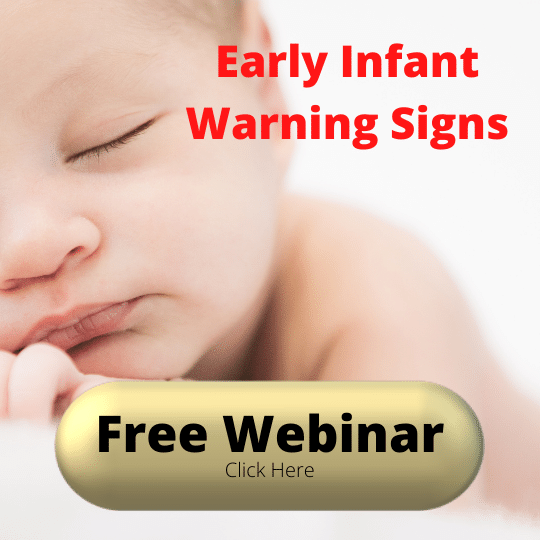Instead of Asking, "How to Swaddle a Baby?" ask "Why?" and What...?"
What are the Affects Swaddling Can Have on Your Baby? Things to Consider Before Swaddling Your Baby.
- Compounded movement deviations occur when a baby is swaddled.
- Swaddling becomes addictive because a baby doesn't know how to move when it is not swaddled.
- Determining whether a baby should be or shouldn't be swaddled, one can use the Newborn Movement Assessment™ to determine if the baby is at high risk or low risk for movement deviations (developmental milestone delays).
- Parents must be careful not to swaddle too much as it can cause developmental milestone delays.
- If a child needs to be swaddled, The child needs Movement Lesson™ or some form of early intervention sooner than later. Needing to be swaddled is an early sign that negative movement deviations are already occurring in the child's system.
Have You Ever Asked, "Should I Swaddle My Baby?"
Let's talk about swaddling. It's not about "do" or "don't do."
We have to offer solutions, but sometimes solutions are offered without understanding, Why is the baby crying?

So to calm a baby down, a lot of people introduce swaddling. But swaddling, lots of times, is also looked at as:
- This is how you get the baby to sleep.
- This is how you get the baby to be still, or
- Swaddling brings back memories of the womb.
Hence delivery! We're done with the womb! Womb time is done!
Understanding the Difference Between a Baby in the Womb vs. a Baby Out of the Womb
In the womb. You are meant to grow in all directions in a frictionless environment.
What does that mean? The difference in the womb is there's no elimination; meaning, you're not breathing, you're not eating, you're not eliminating waste.

A baby encounters friction when
- the cord is around the neck,
- the baby has arthrogryposis, spinal muscular atrophy, microcephaly, or another type of genetic disorder affecting the fetus in the womb,
- the baby's body parts cross in the womb, etc.
When there is friction in the womb, the baby is no longer in neutral. As a result, movement deviations are already starting to occur because the baby is being prevented from expanding in all directions while in the womb.
So the first developmental milestone, actually that happens at birth.

Your bones are meant to be subluxed, and so as the baby is coming out, this is the baby's first exposure to gravity.
So imagine if you had a balloon; a cold balloon from cold temperature going into hot temperature. Just that expansion of helium creates that "whoosh" which is what happens with the parietal bones.
As the parietal bones hit gravity an extension happens. This extension brings out the neck, the shoulders, and all of that.
With this first articulation of the skeletal bones, it goes against gravity. At the same time, cavitation happens as the pallet is pulled up, which creates a cavity in the mouth that pulls on the tongue (this is where the ability to suck is initiated).

So just like the cavitation that occurs when the champagne cork comes out of the bottle and there is all that foam and expansion, the tongue pops and all the nitrogen, oxygen, carbon release into the lungs, an expansion occurs, and the baby takes its first breath.
So there's an expansion of the inner lungs as well as a draw of the breath, and that's where the epidermis and the intercostal muscles between the ribs create muscle tonus.
If those ribs do not expand from the inside out creating that snap or that cavitation that initiates the child's first breath, If that doesn't happen, a child will have muscle tonus issues, either for low tone or high tone.
If your child did not get this at birth due to complications or a c-section you can do the breathing course. This FREE Breathing Course teaches you, step by step, how to initiate this type of breathing that should have happened at birth. Click here to access the course.
Another thing that happens at birth is that this is the first time the bones and skeletal system experience a phenomenon called buoyancy. I discuss this more in my book 'You Can't Get to Mars Without Me! The Rules of Gravity." Click here to buy it.
Don't let the title scare you. This book covers 21 Biological Theories of Gravity and how living organisms function within gravity; which has everything to do with swaddling.
When you swaddle a child, more than is necessary, you are interrupting the relationship your child is supposed to have with gravity. This relationship is crucial for functional milestone development.
Swaddling short circuits a child's ability to play with and experience transitional skills that develop into the baby milestones as you know them.
How to Make a Baby Stop Crying? Ask Yourself Instead, "Why is My Baby Crying?"
It is understandable, you don't want your baby to cry, but it's important to remember that babies need to cry.
It is up to you to learn why the baby is crying.
There's a difference between a baby's hungry cry, their tired cry, their sad cry, their pain cry, their angry cry, and their happy cry.

If a baby is swaddled every time it cries, and the baby is not allowed to express itself, you start misunderstanding what the baby actually needs.
So again, the decision to swaddle a baby is not whether you should or you shouldn't.
If the baby is tired and swaddling helps, by all means, do it.
BUT, if a child NEEDS to be swaddled then the baby needs a Movement Lesson or some form of early intervention sooner rather than later.

Needing to be swaddled is an early sign to you that movement deviations are occurring that can and will potentially affect your child's milestone development.
Instead of looking up clever ways on how to swaddle your baby, and how you can make a baby stop crying with various ways of swaddling; ask yourself, "Why is the baby crying?"
If you look at the top ten baby shower gifts, most if not all of the top ten items are things that inhibit movement and, more importantly, rotational movements.

If you are ever concerned about your child, know that you have a right to be concerned and there should be something available to you to help you know if you should be concerned.
If your doctor says, "Let's wait and see," and three or six months need to go by, that's fine, but in the meantime, there is something you can be doing to help your child's development; that is where Movement Lesson™ is your advocate.
Movement Lesson™ does not fix all your child's problems, whatever they may be, but Movement Lesson™ should be an important piece in your child's overall care.
Try this method for 15 minutes a day for a week and just see how your child's movement changes. Click here to watch the exercises you should do.
Many parents will tell you, "Oh, my child did that and they are okay," but what is okay?
I'm sorry to say you're not getting scientists. You're not getting mathematicians. When a child can move, the brain can develop.

It's not about to swaddle or not to swaddle.
BUT if the baby is not crying, then why is it being swaddled?
The body's development is very interesting and there are very specific movement milestones that should be happening for every child.
But if you have a baby that only know's swaddling or only want's swaddling, that's when it can become addicting for a parent, because nothing else seems to calm the child down.
What the child needs is to learn how to move not being swaddled. Movement Lesson™ does this. In the video below, you can watch how this method does just that.
To learn more about the Movement Lesson™ Infant Developmental Patterns watch the video below that takes you through the movements a child should experience from birth to 4 1/2 months.






